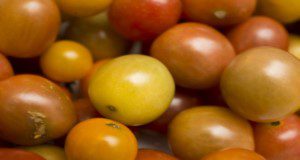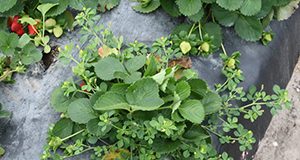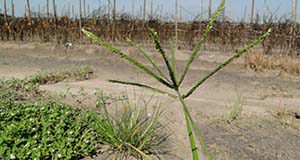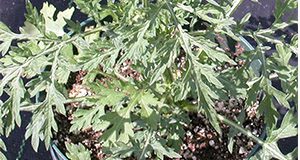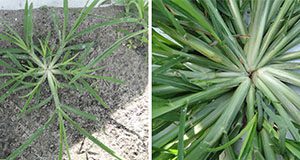Herbicide resistance was historically not a significant issue in most horticultural crops because few herbicides were applied. Close proximity of agronomic crops and the loss of methyl bromide has led to a gradual increase in herbicide inputs and the increased occurrence of herbicide-resistant weeds in tomato fields. Very few herbicides are registered for tomato, and resistance is a major concern. This new 11-page publication of the UF/IFAS Horticultural Sciences Department provides a definition of herbicide resistance, explains how it develops, and provides management recommendations for tomato growers. It was written for growers and Extension agents, but the information may be of interest to anyone concerned about herbicide resistance in vegetable and small fruit crops. Written by Shaun M. Sharpe, Nathan S. Boyd, Ramdas G. Kanissery, and Peter J. Dittmar.
https://edis.ifas.ufl.edu/hs1398
Tag: Nathan S. Boyd
Biology and Management of Pusley (Richardia L.) in Tomato, Pepper, Cucurbit, and Strawberry Production
Four species of pusley (Richardia L.) are widespread and common weeds in Florida vegetable and strawberry production. We refer to the native plant Richardia scabra L. as Florida pusley. This discrimination is necessary because these species are often referred to collectively as Florida pusley due to overlapping distributions, similar growth habits and leaf morphologies, and difficulty identifying without the presence of fruit. This new 6-page publication of the UF/IFAS Horticultural Sciences Department describes the different pusley species and provides management options for strawberry, pepper, cucurbits, and tomato. Written by Shaun M. Sharpe, Nathan S. Boyd, Chris Marble, and Shawn Steed.
https://edis.ifas.ufl.edu/hs1331
Control of Black Medic in Strawberry Production
Black medic is an annual broadleaf weed that competes with strawberry crops and impedes harvest. This 4-page document describes how to manage black medic in strawberry production. Written by Shaun M. Sharpe and Nathan S. Boyd and published by the UF/IFAS Horticultural Sciences Department, July 2018.
https://edis.ifas.ufl.edu/hs1319
Biology and Management of Goosegrass (Eleusine indica (L.) Gaertn.) in Ornamental Plant Production
This six-page fact sheet provides information about the biology and management of goosegrass, including preemergence and postemergence control options. Written by Shawn Steed, Christopher Marble, Nathan S. Boyd, Andrew MacRae, and Kiran Fnu and published by the Environmental Horticulture Department.
http://edis.ifas.ufl.edu/ep538
Biology and Management of American Black Nightshade (Solanum americanum P. Mill.) in Tomato, Pepper, Cucurbit, and Strawberry
This three-page fact sheet describes the biology and management of American black nightshade, explaining how to control for it in tomato and pepper, cucurbits, and strawberry. Written by Nathan S. Boyd, Shawn Steed, Chris Marble, and Andrew MacRae and published by the Horticultural Sciences Department.
http://edis.ifas.ufl.edu/hs1176
Biology and Management of Ragweed Parthenium (Parthenium hysterophorous L.) in Ornamental Crop Production
This six-page fact sheet provides an overview of Ragweed Parthenium, Parthenium hysterophorous L, including a species description and information on how to manage ragweed parthenium culturally, physically, and chemically. Written by Debalina Saha, Chris Marble, Robert H. Stamps, and Shawn Steed and published by the Environmental Horticulture Department.
http://edis.ifas.ufl.edu/ep531
Biology and Management of Goosegrass (Eleusine indica (L.) Gaertn.) in Tomatoes, Peppers, Cucurbits, and Strawberries
This four-page fact sheet gives a brief description of the biology and management of goosegrass, a common annual turf and horticultural weed found throughout Florida that grows well in compact, wet soils and superficially resembles crabgrasses. Written by Nathan S. Boyd, Kiran Fnu, Chris Marble, Shawn Steed, and Andrew W. MacRae and published by the Horticultural Sciences Department.
http://edis.ifas.ufl.edu/hs1178
Biology and Management of Eclipta (Eclipta prostrata) in Ornamental Crop Production
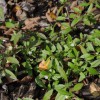 Eclipta grows aggressively in containers and can outcompete nursery crops for water, nutrients, and light. Plants flower in as little as five weeks after germination and produce thousands of seeds over the course of a growing season, and stem fragments left on the soil or media surface following hand-weeding or cultivation can root and reproduce vegetatively. This 4-page fact sheet describes the plant, its biology, and recommendations for physical, cultural, and chemical control. Written by Chris Marble, Shawn Steed, and Nathan S. Boyd, and published by the UF Department of Environmental Horticulture, January 2015. (Photo: Annette Chandler, UF/IFAS)
Eclipta grows aggressively in containers and can outcompete nursery crops for water, nutrients, and light. Plants flower in as little as five weeks after germination and produce thousands of seeds over the course of a growing season, and stem fragments left on the soil or media surface following hand-weeding or cultivation can root and reproduce vegetatively. This 4-page fact sheet describes the plant, its biology, and recommendations for physical, cultural, and chemical control. Written by Chris Marble, Shawn Steed, and Nathan S. Boyd, and published by the UF Department of Environmental Horticulture, January 2015. (Photo: Annette Chandler, UF/IFAS)
http://edis.ifas.ufl.edu/ep512
Biology and Management of Hairy Bittercress (Cardamine hirsute) in Ornamental Crop Production
 Bittercress commonly grows in the potting media of container-grown ornamentals and often through drainage holes in nursery containers. It also can be a problem in propagation houses, greenhouses, and in the field. This 6-page fact sheet provides species description, plant biology, and management recommendations. Written by Chris Marble, Shawn Steed, and Nathan S. Boyd, and published by the UF Department of Environmental Horticulture, December 2014.
Bittercress commonly grows in the potting media of container-grown ornamentals and often through drainage holes in nursery containers. It also can be a problem in propagation houses, greenhouses, and in the field. This 6-page fact sheet provides species description, plant biology, and management recommendations. Written by Chris Marble, Shawn Steed, and Nathan S. Boyd, and published by the UF Department of Environmental Horticulture, December 2014.
http://edis.ifas.ufl.edu/ep511
Weed Management Principles in Commercial Vegetable Production
 Weeds compete with vegetable crops for light, water, and nutrients. This competition decreases plant vigor, yield, and crop quality. They interfere with hand harvest and can complicate or prevent machine harvest. Weeds also serve as alternative hosts to diseases, viruses, and nematodes. A successful weed management program will incorporate multiple control practices with preventative, cultural, biological, mechanical, and chemical methods.
Weeds compete with vegetable crops for light, water, and nutrients. This competition decreases plant vigor, yield, and crop quality. They interfere with hand harvest and can complicate or prevent machine harvest. Weeds also serve as alternative hosts to diseases, viruses, and nematodes. A successful weed management program will incorporate multiple control practices with preventative, cultural, biological, mechanical, and chemical methods.
This 6-page fact sheet was written by Peter Dittmar and Nathan Boyd, and published by the UF Department of Horticultural Sciences, July 2014.
http://edis.ifas.ufl.edu/cv113
Biology and Management of Common Purslane in Fruiting Vegetables, Cucurbits, and Strawberries
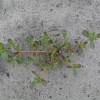 Purslane occurs throughout the year in Florida. It produces thousands of seeds per plant, which germinate readily, but can also persist in the soil for up to 15 years. Vegetative shoot fragments can survive on the soil surface for extended periods of time, then re-root when exposed to moisture and can even flower and produce seeds after they have been pulled from the soil. This characteristic enables purslane to persist and spread following cultivation. This 4-page fact sheet was written by Nathan S. Boyd, Andrew W. MacRae, Rick Kelly, and Ixchel M. Hernandez, and published by the UF Department of Horticultural Sciences, July 2014.
Purslane occurs throughout the year in Florida. It produces thousands of seeds per plant, which germinate readily, but can also persist in the soil for up to 15 years. Vegetative shoot fragments can survive on the soil surface for extended periods of time, then re-root when exposed to moisture and can even flower and produce seeds after they have been pulled from the soil. This characteristic enables purslane to persist and spread following cultivation. This 4-page fact sheet was written by Nathan S. Boyd, Andrew W. MacRae, Rick Kelly, and Ixchel M. Hernandez, and published by the UF Department of Horticultural Sciences, July 2014.
http://edis.ifas.ufl.edu/hs1238
